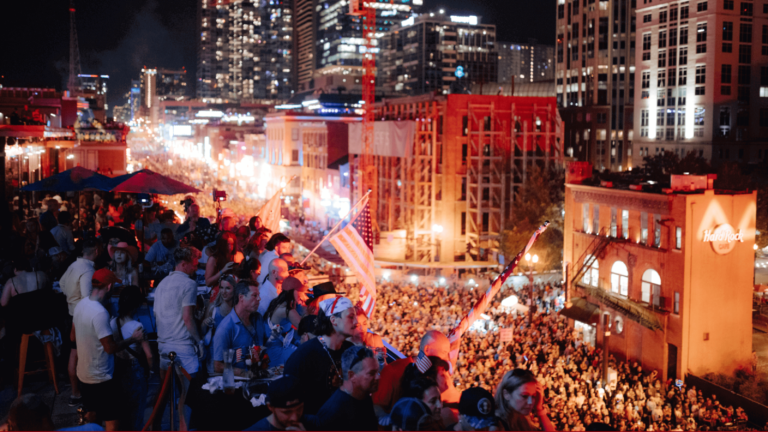It’s finally time to move past all that pre-event research and put the wheels in motion to plan, organize, and host your next event.
Then it hits you:
There are more wheels than you thought!
How are you going to make sure everyone is on the same page?
With an event brief.
At Eventbrite, we’ve been in the event game for over 15 years, and we know that comprehensive event briefing is key to ensuring all your organizers, stakeholders, and support people are aligned.
That’s why we’ve designed a free event brief template just for you, and in this guide, we’ll walk you through how to use it.

What is an event brief, and what is it for?
An event brief is a master document that covers all of the key elements of an event.
It details everything from the purpose and goals of the event down to an itemized budget and proposed timeline for event organization.
An event brief is typically created by the event organizer or head of the event planning committee, though it’s used by everyone involved in event creation.
Its overarching purpose is to ensure that everyone working on planning and organizing the event:
- Is aligned toward the same goal
- Has the same understanding of everyone’s involvement and responsibilities
- Has a single source of truth to refer back to in the event of confusion or if questions pop up
Reach more people with our all-in-one event marketing solution

8 must-have sections to include in your event brief
About to create your first event brief? Make sure you include all the important sections:
1. Event overview and key details
5. Roles, responsibilities, and logistics

1. Event overview and key details
The first section of the event brief should summarize the entire document.
Give an overview of the event (what the event is, who it’s for, key guests, etc.) and provide the four key event details:
1 . Name
2 . Coordinator
3 . Date
4 . Budget
Here’s an example of what this might look like:
| Event key details | |
| Event Name | Shining Stars Showcase |
| Event Coordinator | Olivia Summers |
| Event Date | 12 April 2024 |
| Event Budget | $25,000 |
| Event overview | |
| “Shining Stars Showcase” is a fundraising event. We will celebrate the skills and talents of children facing terminal illnesses through a heartwarming talent show. Featuring diverse performances and interactive elements, this event is designed not only to raise funds for the children participating but to encourage camaraderie and empower these youngsters to be more than their illness. |
The event brief description allows stakeholders to quickly grasp key details without digging deep into the document.
💡 Pro tip: Write this section last, when you’ve got all the details ironed out, so you don’t have to rewrite it several times.
2. Purpose and goals
The next section of your event brief gives some details about why the event exists.
First, define the purpose of your event. How does your event serve those who will attend?
Then, add your event goals, including hard metrics where possible and relevant, so it’s clear to everyone what the event priorities are.
| Event purpose and goals |
| The “Shining Stars Showcase” offers a platform for children battling terminal illnesses. It will help to nurture their confidence, create connections with children going through a similar experience, and celebrate their unique talents.This event will also raise funds to support the medical needs of the children involved. |
| Raise funds: Raise $100k+ for children with terminal illnesses. |
| Empower through expression: Enable the kids to express their unique talents and creativity on stage. |
| Community connection: Create an encouraging environment that helps children in similar situations connect and support one another. |
Your event goals help ensure everyone is working toward the same goal and can also guide decision-making during the event organization process.
3. Target audience
The target audience section describes your ideal event attendees.
Some events may have more than one target attendee. That’s fine. Just make that clear when you fill out this section.
Here’s an example of how you might describe your target audience:
| Target audience | |
| Our target audience includes: • Families and friends of the children participating and those with children facing terminal illnesses • Healthcare professionals and social workers • Local community members and volunteers |
This section will help define targeting when it’s time to dive into marketing and ensure your theme and concept remain relevant.
💡 Pro tip: If you’ve hosted similar events previously, use a breakdown of ticket holder information to inform your target audience section. With Eventbrite, you can do this by going to your Organizer Dashboard and clicking on Reporting > Analytics.
4. Event theme and concept
The event theme and concept section outlines your event’s look and feel and may even include callouts to previous events and imagery to illustrate the style you’re aiming for.
Here’s an example of how you might describe your event theme and concept:
| Event theme and concept | |
| The event theme will be “Radiant Resilience,” aligned with the “Shining Stars” event name. We will embody this theme through vibrant decorations, radiant colors (bright yellows and warm oranges), sparkling star motifs, and LED light installations. |
Describing your event theme here guides your decision-making regarding designing and decorating the venue to create a truly memorable experience for attendees.
💡 Pro tip: Include imagery to help your team visualize the event, for example:
- Mood boards
- Thematic visuals
- Venue photos
- Decor and styling examples
- Past event photos
- Color palettes
- Branding elements
- Layout plans
- Entertainment and speaker imagery.
5. Roles, responsibilities, and logistics
Here’s where you start getting into the details of the event.
It’s time to describe everyone’s key responsibilities and categorize team members into working groups.
The Event Logistics section in the table below provides a high-level breakdown of operational planning, such as who delivers seating for the event and when.
Here’s an example of what this section might look like:
| Event roles & responsibilities | |
| Lily Evans – Event Coordinator | • Oversee the event’s overall planning and execution. • Coordinate volunteers, vendors, and performers. • Develop the event timeline. • Manage the budget and fundraising efforts. |
| Ethan Clark – Marketing and Outreach Manager | • Develop and implement a marketing strategy. • Coordinate with media, sponsors, and community partners. • Manage social media campaigns, press releases, and promotional materials — both before and during the event. |
| Oliver Hughes – Emotional Support Coordinator | • Work closely with healthcare professionals to address children’s emotional and psychological needs. • Provide support and resources for families, participants, and event staff. |
| Harper Lee – Sponsorship and Fundraising Manager | • Identify potential sponsors and partners. • Initiate and manage fundraising campaigns. • Maintain sponsor relationships. |
| Event logistics | |
| Participant Coordination • Confirm participant details, acts, and availability. • Coordinate transportation and special requirements for participants. Supplies and Logistics • Arrange vendor contracts for ◦ Catering ◦ Decorations ◦ Technical equipment • Procure necessary supplies such as ◦ Decor ◦ Signage ◦ Badges ◦ Event materials • Coordinate delivery, setup, and removal of equipment and supplies for smooth event operations. |
Getting clear on who’s responsible for each task helps avoid duplicate work and ensures the event runs smoothly because everyone knows what to expect.
💡 Pro tip: Larger events will have more roles and responsibilities. To avoid making the event brief too in-depth, just include the names and roles of each person involved and link to a separate document detailing their job descriptions.
6. Marketing and promotion
This section of your event brief describes all the activities you’ll engage in to attract attendees to your event and sell tickets.
Here’s an example of how you might detail the event marketing and promotion section:
| Marketing and promotion | |
| Social Media: Facebook, Instagram, and Twitter. Activities: Share stories, teasers, updates. Goals: Boost awareness, drive ticket sales, and engage the online community. Local Media: TV, Radio, and Print Activities: Interviews, stories, press releases Goals: Gain community support, and highlight event impact Activities: Updates, event info. Goals: Engage attendees and encourage ticket sales and donations. |
This section of the event brief is super important. Without marketing activities, nobody will know that your event is happening, so no one will turn up!
Event marketing is a lot of work, so you’ll want to consider how to streamline the process to make it manageable. Eventbrite’s Marketing Tools help you create and distribute promotional emails, ads, and social media posts taking advantage of the latest technology in AI and automations to make the event marketing process as easy as possible for you.
Start your event marketing planning today.

💡 Pro tip: At this point, your marketing and promotion plans might be fairly high-level. That’s fine. Come back to this later when you have more details, or drop in a link to your full marketing plan.
7. Budget
The budget section breaks down how the total event budget is spent across different categories.
You want to include how much you’re allocating to the marketing and promotional activities described above, how much you have set aside for catering, and so on.
Here’s an event brief example of an event budget section:
| Budget | |
| Venue Rental and Setup | $6000 |
| Participant Coordination and Support | $4000 |
| Supplies and Logistics | $5500 |
| Volunteer Management and Support | $2000 |
| Marketing and Promotion | $3000 |
| Safety and Health Measures | $2000 |
| Miscellaneous Contingency | $2500 (10%) |
Close to a quarter of event organizers say their biggest challenge is budget constraints.
Use this section to help solve those constraints by researching prices and costs, and outlining in detail where you should allocate the budget.
💡 Pro tip: Keep a 5–10% contingency in your budget to take care of those unexpected items that might pop up.
8. Timeline
Finally, we have the timeline section.
This is where you use a chronological order to plan out the various tasks required to plan and organize the event.
Here’s an example of how you might communicate your event timeline:
| Timeline | |
| January–February 2024 | • Secure venue • Coordinate participant acts • Begin marketing efforts |
| February–March 2024 | • Logistics planning • Volunteer recruitment and training |
| March–April 1, 2024 | • Finalize event details • Double down on marketing • Design safety protocols |
| April 2–April 11, 2024 | • Conduct final run-throughs • Coordinate volunteers • Prepare last-minute logistics |
| April 12, 2024 (Event Day): | • Execute the “Shining Stars Showcase” • Coordinate live social media efforts • Celebrate with participants and attendees |
The timeline section keeps the entire event planning team on track. It ensures you don’t fall behind as you progress and allows you to catch any balls you drop along the way.
💡 Pro tip: Make this section a simple overview of the project timeline, and be specific about your dates to improve planning. Use a project management tool like Asana or Trello to go into more depth and develop your timeline, add subtasks, and assign to the people responsible for each task.
Best practices for creating an event brief
Before we sign off and let you dig into creating your very own event brief, here are three quick best practices to bear in mind to help you nail your event brief.
Research and plan before drafting your brief
There’s one step that should come before you create the brief, and that’s research and planning.
This should include activities like digging into data from previous events to see what worked and investigating competitors and similar events for inspo. You should also ensure accurate pricing for the main expenses, such as the venue, food, equipment, and staff.
Use your team to delegate sections of the brief
Creating an event brief can be a huge task.
Use your team to help you build it out and take a bit of work off of your plate. For example, your marketing leader can fill out sections three and six.
Ensure the brief is a living document
While the idea is that the brief is a master document that everyone follows, the truth is that changes can happen.
Budgets will likely need adjusting, timelines may change, and sometimes, responsibilities will shift as you move closer to the date.
To manage any hiccups, use a cloud platform like Google Docs (rather than an offline Microsoft Word doc) so you and your team can leave comments and make edits immediately. You can keep all your important documents there for everybody to access: your event marketing plan, health and safety information, branding documents, and even your debrief document once your event’s over.
Start creating your event brief today
Event briefs are critical for ensuring alignment across the entire team.
They act as a central source of truth everyone can refer back to and they help minimize the back and forth between team members. This can dramatically reduce time-waste and free your team up to produce their best event ever.
Want to save even more time and make your event planning process smooth and efficient? Eventbrite offers tools and resources to help you structure your event planning, make your event promotion efficient, and execute your events like a pro.






